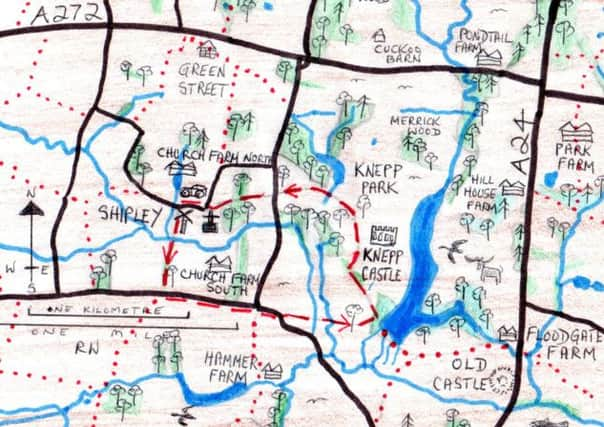RICHARD WILLIAMSON: Country walk: Knepp Castle


Parking is available in bays by Shipley windmill south of the A272 between Coolham and Cowfold: TQ143219.
The famous windmill, monument to Sussex writer Hilaire Belloc after his evocative poem, has its sails down and has apparently been awaiting repair for some time and, sadly, is not currently open to the public.
Walk south down bridleway keeping it to
Advertisement
Hide AdAdvertisement
Hide Adyour left into an old shaw (term for public walkway drained in medieval times) and rue (a line of trees) crossing the headwaters of the River Adur.
Rich ground flora in spring of bluebells, wild garlic and stitchwort.
There are old oaks, hawthorn and field maple with blackbirds, great tits, robins and great spotted woodpeckers, all keeping company together.
Turn left along road for 550 yards then right, straight on at junction to Dial Post along Swallows Lane. After 200 yards left through hedge on fingerpost into meadow.
Advertisement
Hide AdAdvertisement
Hide AdKeep to right of an old oak, eventually arriving at footpath sign and the path ahead over long footbridge.
Then cross newly-made meadows of the River Adur that are planned to make a more traditional flood plain catchment area.
Continue east across next meadow, following a line of old oaks with roots damaged by cattle in the past.
At the cottage turn left onto estate road between some of the 100-plus kms of Knepp hedgerows kept for wild birds as well as shrub species.
Advertisement
Hide AdAdvertisement
Hide AdAt New Lodge a fingerpost directs you north-north-west across the park, with its old oaks and view of the house on the right. ‘Knepp’ derives from the Old English ‘Cnaepp’, meaning hilltop. The old Norman castle lies south-east by the A24.
The new one was built by Nash in 1809, destroyed by fire in 1904 and rebuilt exactly, complete with mock Norman castellations.
The interior rooms are furnished from various great houses including Irish and London, one with chimney piece of 1655.
House martins nest under the window ledges, attaching mud cups to the stucco walls. Two ancient wisterias cling to the building, making coloured drapes when in flower. The herd of fallow deer roam freely and should be seen grazing. The large lake was made to power the Elizabethan hammer mill making iron for implements, firebricks, and harness among other uses.
Advertisement
Hide AdAdvertisement
Hide AdJoin the entrance drive for 300 yards north-west before turning west on the fingerpost to the road. Cross this and stay west to Shipley where turn left into the village. This woodland is rich with bird life.
I heard blackcap warbler, song thrush, robin, blackbird, wood pigeon, great spotted woodpecker, nuthatch, great tit – just a few of the total species that inhabit the area.